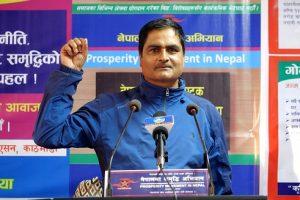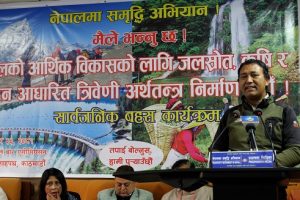Prof. Timila Yami Thapa
Nepal has prepared a Digital Framework 2019 unlocking Nepal’s Growth Potential to further the Government’s vision of “Prosperous Nepal, Happy Nepali” with broad objectives to address the development challenges facing the country. In addition, there are specific plans in health, education, and social protection sectors that are currently either being extended or revised taking into account post-covid reality. It is designed to facilitate Nepal to connect its driving socio-economic growth of citizens which will help and support to achieve the sustainable development goal. Information and communication technologies (ICT) are increasingly available to advance the ease and efficiency in many areas of life. ICT holds particular promise in areas of governance and public participation. Governments in the digital age can use information to reduce corruption and increase government transparency, accountability, efficiency and citizen participation. Human rights advocatescontend that successful use of ICT in governance requires access to information, education and the ability to share information for citizens
Eight Sectors and Eighty Digital Initiatives under the Digital Nepal framework, eight sectors – digital foundation, agriculture, health, education, urban infrastructure, energy, tourism and finance have been identified based on close engagement with stakeholders. The Government’s big plan Digital Nepal is designed to facilitate Nepal to connect its driving socioeconomic growth of citizens which will help and support to achieve the sustainable development goal.
Technology and Infrastructure
Earthquake and COVID-19 pandemic has taught people worldwide the importance of digital connectivity and needs to be a key priority. Countries have started declaring to make Internet access a fundamental right for every citizen. This requires improving availability of radio frequency spectrum to the operators to enhance service coverage and quality. New leadership is required to take leadership in driving 5G adoption followed by nationwide establishing a nationwide fiber network. It is essential to strengthen a strong team of experts driving such ambitious digital leadership functions who will also be competent enough to facilitate development of a robust financial ecosystem encourage digital payments, attracting investments in Fintech by encouraging the growth of startups and telecom companies to offer services to drive financial inclusion.
Nepal plans to connect the people around the nation with the high speed, reasonable and easily accessible internet plans to provide service to citizens’ door to door using ICT. However Nepal has not seriously worked a sustainable model to provide citizens access to the internet at an affordable rate for launching e-education, e-tourism, e-health, e-agriculture, smart city smart home and smart government. Nepal has remained digitally uninitiated because of issues on affordability, digital divide, access, and digital illiteracy. This is due to poor ICT infrastructure, financial resources, geographical diversity, low skilled human resource, technology import, its upgrading and maintenance, the digital divide between citizens, crucial and poorly managed bureaucratic function, unsystematic working processes, weak policies, gaps and lapses; and lack of proper government’s monitoring, supervision and control mechanism.
Talent and Skills Development
The Education Ministry should bring out a policy of introducing a new model for bringing impact on advanced ICT education including implementing ICT literacy programs for rural communities and underprivileged citizens. Rural transformation is a big global project in the world scenario for meeting the need of ambitious digital transformation worldwide. Around 50% of the developing world’s population (Nepal: 80%; India:66%; China: 40%) is living in the rural sector, mostly in agrarian sectors with lack of incentive and facilities for modern education systems. A large percentage of them are impoverished and do not have access to the latest electronic technology and digital transformation revolutionizing the urban world because of the availability of information. This is becoming a situation of a digital divide between the rural sector and urban sector.
Public-private partnershipis required to incorporate special stakeholders to increase ICT infrastructure and generating skilled human resources including enhancing ICT infrastructures. Promotion of e-Commerce and social advertising and marketing to attain global markets and developing superior applications to prepare IT employees for cloud offerings, cybersecurity, and large facts have become essential.
Nepal was slow in introducing Electronics Engineering curriculum compared to our neighboring countries such as India and China. Premier institutions and multiple campuses under Tribhuvan University only started Electronic Engineering discipline as late as the year 1994 because of the lack of availability of resources and suppression of Education during Rana’s regime. Computer Engineering was started in 1998 at Institute of Engineering (IOE), Pulchowk Campus. I played a key role in designing curriculum in the IT field of both Tribhuvan University and Pokhara University in the early starting phases. Unfortunately, commercialization of the Internet and information technology in the world coincided with the introduction of Electronics Engineering in Nepal. Because of the huge job market created by the Internet Commerce around the world, large numbers of IOE graduates of Electronic Engineering were sucked into Information Technology because of higher remuneration and better opportunities in foreign industry.
In anticipation of the coming wave of Information Technology, I started my software company in the year 1991. With the wave of Internet Commerce, I was successful in generating good employment through my software company within Nepal. I also attracted many rural talents in my company. Along with my academic contributions, I also blended my IT industry experiences, having executed successfully many software projects both in public sectors and industry in Nepal. I could take those experiences into the academic sector in earlier days because of my involvement in the academic sector.
Tapping talents from rural areas requires investments. I have witnessed the talents of rural and economically backward students who have competed in open competition to get enrolled in premier public institutions at Institute of Engineering, Tribhuvan University in earlier days. If the Digital Nepal framework has to be successfully implemented for overall growth of the society, including rural society, public institutions and other campuses of Tribhuvan University have to be strengthened, and adequate scholarships have to be provided for bright students.
Women’s agenda
Despite strong evidence regarding the importance of fully incorporating women into the Information and Communication Technologies (ICT) sector, a gender ICT gap still remains in Nepal. Moreover, women are underrepresented in the sector, particularly in technical and decision-making positions. Barriers include lack of role models, lack of limited gender specific networking opportunities as well as the investment one needs to remain up-to-date in this fast-moving industry constantly updating one’s technical skill – stay current. The technological world evolves very quickly and one has to be self-learning all the time.
There are reservations for women in electoral politics and in government services, one of the fundamental pillars of the post-2006 compact—proportionate representation in all state bodies. However, this power has been ignored during implementation of the constitution. Citizens now feel that most of the attributes such as secularism, inclusion, federalism, and even democracy are only limited in documentation only.
Building Technology platforms, Policies and Playbooks for Product Entrepreneurs.
The critical insight to a Nepal’s journey of success is that it requires one to be able to work with and grow the ecosystem, rather than grow itself. IT sector also needs to have volunteers from not-for-profit Think Tank, staffed mostly by volunteers from the tech world, who dedicate their time, energy and expertise towards Nepal’s hard problems. This group should remain committed to being in the background, taking pride in the success of partners who are solving Nepal’s hard problems.
The motivation for volunteering is hard to explain to those who have not experienced the joy volunteering brings. They should find market players and government entities with the conviction in this approach and help everyone work together and function together. In practical terms, this means that the government builds the digital public infrastructure, and the market participants build businesses on top of it. Groups in regional countries have iterated this model and are continuing to improve and refine this model. To play such a role they use their mission to align with the Government partners, Market partners and their own volunteers.
They should convert ideas into policy proposals to take to the government, stakeholders. As part of their advocacy efforts they should explain, educate and inform government policy makers and other policy bodies that a vibrant software product industry is vital to Nepal’s future. They should have symbiotic relations with trade organizations including professionally run institutions like NASSCOM in India and see them leading the charge of converting policy prescriptions into reality. Computer Association Nepal should be driven by professionals like the leaders of NASSCOM.
People are talking about movements required to protect rights of the marginalized. Late Dharma Ratna Yami through his books like Hamro Rastriyeta, Nepal Ka kur etc. had all the guts to write about the need of inclusive democracy during early AD 1940s and 1950s. We need such courageous writers too.




